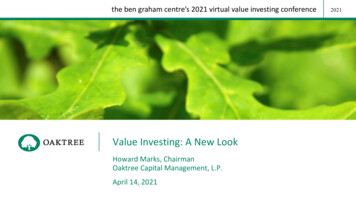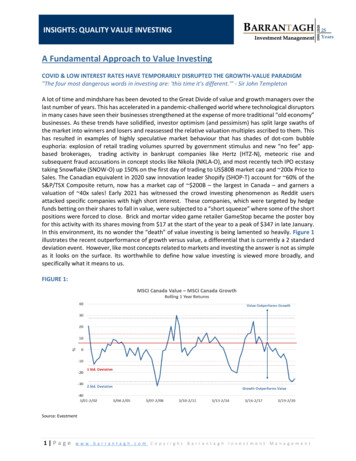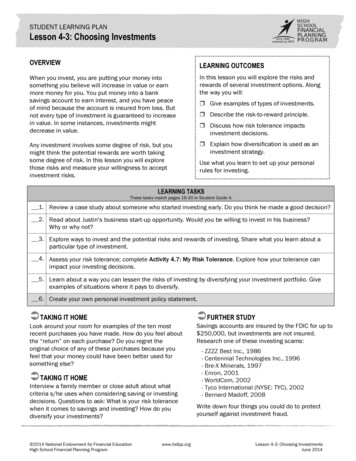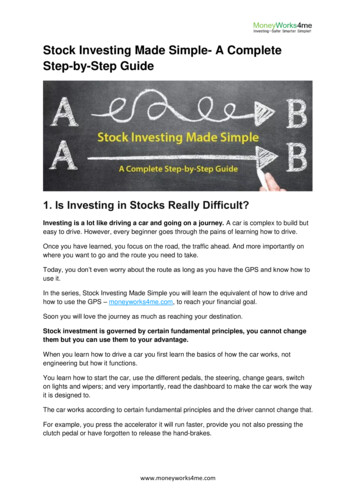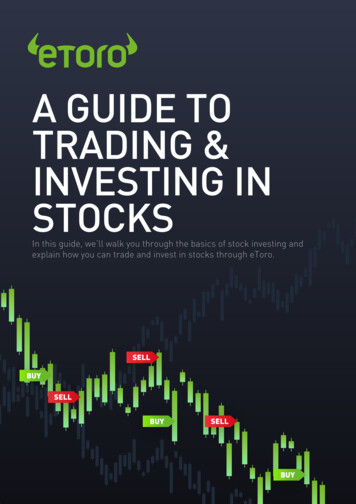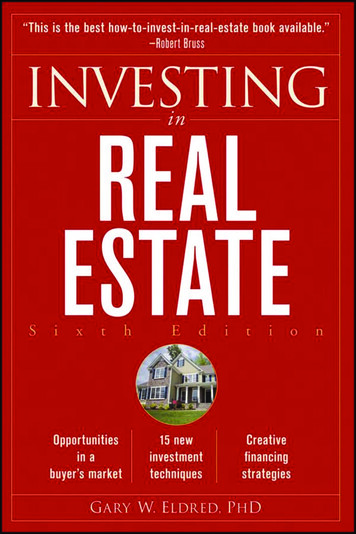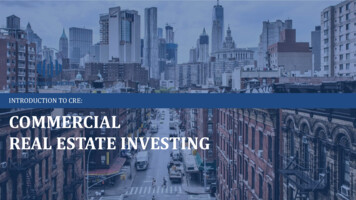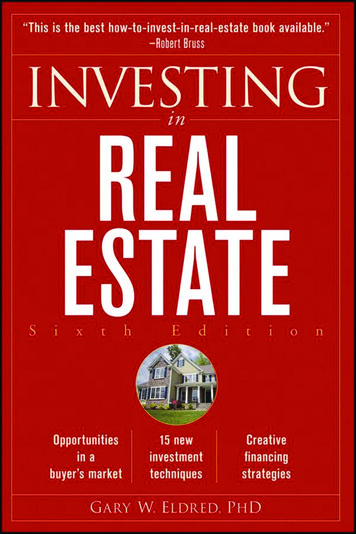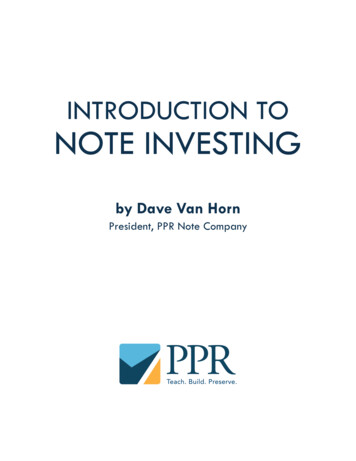
Transcription
Introduction toNote Investingby Dave Van HornPresident, PPR Note Company
Table Of Contents1.2.3.4.5.6.7.8.9.10.11.From 100 Houses to 100 Notes3Why Invest in Notes? 12How Notes Work 22Where to Find Notes 26Due Diligence 31Profitable Note Investing 37Recapitalization 45Sources of Capital for Notes50How to Get Started in Real Estate Notes 54FAQs 59Note Investing Glossary 63Introduction to Note Investing by Dave Van Horn2
Part 1From 100 Houses to 100 Notes“100 Houses.” That’s the answer I often hear when I ask realestate investors new and old: “What is your ultimate investinggoal?” Believe it or not, I actually used to have the same response:not 100 notes, but 100 houses. That was my original plan forbuilding wealth, and by the age of 45 with 40 units to my name, Iwas well on my way to getting there. At the time, I was a seasonedinvestor, who had tried everything from stocks and bonds toprecious metals, and, with real estate, I thought I finally had it allfigured out. My plan was to reach about 100 properties or units,ultimately getting as many as possible fully paid off. Doing sowould allow me to have versatility with my holdings with the abilityto buy, sell, or borrow against properties to generate income orto acquire more assets. More importantly, my debt-free portfoliowould also provide me with more than enough cash flow to finallybe financially free, especially in retirement. After all, isn’t financialfreedom what we’re all after?My Early Days as a Property InvestorWhen I first started investing, the idea of financial freedom wasn’teven on my radar; I just wanted to “get ahead.” At the time, I hadIntroduction to Note Investing by Dave Van Horn3
just started a family and was working two jobs, just barely gettingby. I was also looking to move out of our apartment and upgradeinto a house of our own. So, I thought the best way to solve bothproblems was to buy a multi-unit property that I could live inand rent out to make extra money on the side. And guess what? Itworked! It was a great first step and one that inspired me to keepgoing. Like many investors reading this book, this is how I startedmy investing career.I eventually moved onto purchasing buy-and-hold rental propertiesas well as flipping houses. And, like most people, I was usingtraditional bank financing and personal income (the extra moneyI made in commissions from my second job as a realtor) to buymy first few properties. Implementing both of these things waswhat got me over the first hump of buying my first few houses,but it didn’t last very long. One problem was that it was a get-richslow model, especially when working two jobs just to save up for adown-payment. The other problem was, after buying my first fewhouses, I started to look for more properties to rehab and couldn’talways qualify for traditional loans. I was running out of financingoptions, or so I thought.Trying to figure out my next move and still unsure of my investingfuture, I decided that maybe the answer (or at least more income)lay in becoming a real estate broker. The teacher of my real estatebrokering class was an old realtor/broker, who had seen and doneIntroduction to Note Investing by Dave Van Horn4
it all. On the first day of class, he took out our textbook and said,“There’s nothing in here that I can teach you,” and he threw it in thetrashcan! Everyone was speechless, including me. He then exclaimed,“But what I can do is show you how to buy a house with none of yourown money.” Needless to say, all of us were skeptical, but we listened.After that day in class, I went home and thought over what he told us,finally deciding that what he said could really work.So, without any disposable income left to invest or a bank to turnto, I found the only thing I had left was good credit and the abilityto take risks. At the time, cash advance fees didn’t exist like theydo today, and credit card companies would provide customerswith credit card checks for cash advances. The strategy was simple:I would write a credit card check out to myself, deposit it, andthen obtain a certified check from the bank to pay for a house. I’dessentially pay cash for the property (allowing for me to negotiatea better deal), fix up the house with another credit card, thenfind a tenant and refinance to pay off all of the credit card debt Iaccumulated.I’m working to quickly go through and break up thelonger paragraphs where it makes sense.Sometimes I would pay off the credit cards and still have somerefinance money left over (tax free because it was technically aloan), which I could then use to reinvest. So, I basically got thehouse for free, had tax free cash in my pocket, and the tenant wouldpay back the refinance loan while I would still be earning positiveIntroduction to Note Investing by Dave Van Horn5
cash flow. This is how I got started on my path to financial freedom,and this strategy exemplifies what I learned in class that day: thatleverage is the key to building wealth and that it can be applied tonearly every business in a multitude of ways.Something Happened On My Way to the Local REIA GroupIt wasn’t until I discovered notes, mainly by accident, that I realizedhow cumbersome and time consuming my goal of 100 houseswould become. After getting to 20 units by utilizing bank financingand my credit card strategy, I hit another wall when looking forcapital for my next project. The banks would no longer lend to mebecause I had too many “doorways” or mortgages in my name, andcredit card companies became stricter with their cash advances,eventually raising the fees so high that my old model wouldn’twork. I thought I was finished, but then I remembered hearingabout a local REIA (Real Estate Investors Association) groupholding meetings in my area. It may seem like a no-brainer today tojoin a real estate networking group to find a hard money lender, butI was a bit of a lone wolf when it came to my properties and actuallyhad no clue how hard money worked. I went to my first meetingjust to network with others and hopefully learn how they foundcapital for their real estate deals.I’ve since learned that networking isn’t just crucial to the realestate industry, it’s crucial to every industry. After I attended a fewIntroduction to Note Investing by Dave Van Horn6
meetings, my network started to grow, and this new network ofmine taught me something the bank never could: instead of saying“I can’t,” they taught me to ask “How can I?”Turning to Private Money and Private NotesIt was at a meeting of this group that I was first introduced toprivate money. Through one of the speakers at the event, I learnedthat just as a bank can issue a loan and make a profit through theinterest payments, so can an individual investor or hard moneylender. It was this speaker, who personally introduced me to aprivate money lender, who lent me the capital I needed for mynext purchase. So, just like that, I was back on my feet purchasingproperties, faster than ever. Using private money, I was able toobtain my highest number of real estate rentals ever, 40 unitstotal, all in the span of a few years. I even started managing otherinvestor’s units as an agent alongside my own since most of theproperties were located in the same area as mine, it was an “easy”way to make some extra money on the side.Everything was going great, and I was busier than ever. I meanreally busy. so busy that I didn’t have much time to sparebetween the management of my own properties as well as otherinvestors’. Then one day it hit me: between the maintenance, tenantcomplaints, inspections, and constantly going to eviction court, Irealized I was working for my money rather than letting it workIntroduction to Note Investing by Dave Van Horn7
for me. I was squandering my greatest asset of all: time. It wasat that very same moment when I figured out who wasn’t doingany of these things for their investments but still making a profit:the private note owner. That’s when I decided for a bit of a careerchange, and became a private money lender myself. With many ofmy properties having risen in value in recent years, I had built upquite a bit of equity. I refinanced this equity out of my propertiesand started lending it to other investors I met at networking groups,again utilizing leverage. This is what is known as a private note, andit’s how I first got started in the note business.note : a promise to repay a loan.In the note industry, this promise is in the form of a contractin which one party (the borrower) agrees to repay a certainportion of the loan to the other party (the lender) within a setperiod of time and under specific terms (including interest rateon the loan, penalties for late payments, etc.).From Private Notes to InstitutionalI had come to private notes looking for a better investment - onethat was passive but just as secure and versatile as real estate. Inmany ways I found those qualities creating notes as a private moneylender--I was no longer bogged down by maintenance or tenants,Introduction to Note Investing by Dave Van Horn8
and I was making a safe and comparable return to my cash flowingrentals. But, as the real estate market nearly came to a halt with the2008 recession, I was again looking for a change. With investorspurchasing less property due to declining values and their main exitstrategy of refinancing becoming increasingly harder to accomplishdue to lending restrictions, private money was turning into moreand more of a struggle with a high default rate.Like all investments, private notes are not without theirdisadvantages, and scalability had always been one of them. Withcurrent legal requirements limiting the amount of private notes thatcan be originated per year for an individual, scaling the amount ofprivate notes was proving to be difficult. Even lending to entities orLLCs, which can be much less limiting in terms of usury laws andorigination requirements, still involves extensive underwriting anddue diligence. Not to mention, the duration of most private notesare fairly short (24 months or less), leaving investors like myselfconstantly searching for the next borrower and another deal todeploy capital. These disadvantages were only heightened by theeconomic downturn setting the stage for my next opportunity:institutional notes.Luckily, a few years before I found myself at this crossroads, I hadstarted a real estate networking group of my own to accommodatemy expanding network; it was at this group that a new speakercame to visit. He was an institutional note fund manager lookingIntroduction to Note Investing by Dave Van Horn9
for capital to purchase pools or tranches of delinquent mortgages.At the time, I wasn’t familiar with how you made money on adelinquent mortgage, which I soon found out was a mortgage inwhich the borrower is more than 90 days late on their payments.He explained a bit about how it worked, and I was intrigued bywhat he had to say, but like most of the people in that room thatday, I didn’t act. Fortunately, my future partner John did.John invested some money in this note fund and began earningsignificant returns. More importantly, he became interested in thebusiness model behind delinquent notes. Eventually, John set up ameeting between our friend (and future partner) Bob and myselfto determine if we would be interested in raising money for a notebusiness. After explaining to us what he knew about the business,we agreed to form an entity and purchase our first few notes. It wassoon after working through our first batch of notes, profiting fromsome and learning from the rest, that we decided to raise moneyto buy more. Once I started receiving the passive income fromthese, without all of the headaches of my past ventures, I decided tochange my goal of 100 houses to 100 notes.The New Goal to Financial Freedom: 100 NotesNow 100 notes may seem like a daunting goal to strive for andmay even be a bit of an arbitrary number. The real goal is to haveas many notes and properties as possible to create and maintainIntroduction to Note Investing by Dave Van Horn10
financial freedom. But, just like when I started buying property,gaining more assets was a steady incline.When starting out in real estate, my goal initially was to purchaseone property, then five, then ten, and so on and so forth. The longestand most arduous process wasn’t when I went from ten to twentynotes, or even from one to ten, it was buying my first one that provedto be the biggest step. The reason for this is that when I started outthere wasn’t much information available on buying, working, andmanaging notes, and I certainly didn’t know very many people doingthe business who had gone through a similar process as me. That’swhy after years of owning and managing a note company that nowpurchases and owns thousands of loans, I decided that I would takeon this position that still needed to be filled.The goal of this book is to show through my personal experiencehow notes work, how to get started, and how along with real estateand other investments, notes can be a great investment vehicle tobecoming and staying financially free.Introduction to Note Investing by Dave Van Horn11
Part 2Why Invest In Notes?Almost everyone is already in the note business, they’re just on theother end of it. It’s hard to find a person who doesn’t have a creditcard, car loan, student loan, or mortgage. The problem is that mostpeople are writing a check to a note owner instead of receivingone as a note owner. The best way to get to the other side of thatequation is to start owning notes, rather than the other way around,and to do so one must start by gaining a better understanding ofthe institutional note business.A performing note (also referred to as a re-performing note) is aloan on which payments of interest and principal are less than 90days past due. A re-performing loan is simply a note that had gonedelinquent but has since entered performing status after at least atwelve month pay history.A non-performing note is a loan that is in default or close to beingin default. Many loans become non-performing after being in defaultfor three months, but this can depend on the contractual terms.**When reading this book, it is important to remember thatany further mention of notes refers to secured notes; and, morespecifically, it refers to secured residential notes in the first andIntroduction to Note Investing by Dave Van Horn12
second position. Keep in mind, there all kinds of notes that varyin type and position. The previously mentioned are notes thatare backed or secured by an asset (in this case hard real estate),but there are also unsecured notes as well; examples can includestudent loans, medical debt, and credit card debt.**Advantages of Investing in Institutional Notes#1 - Passive Cash FlowFor me, owning hard real estate always had and still does offermany great tax advantages, especially when including depreciationdeductions that can offset positive cashflow. Although I considermy real estate to be passive from an IRS tax perspective, what manypeople including myself have failed to realize was how much activework is required for managing and maintaining property. For theowner/landlord active work can include everything from dealingwith tenants and their liability to maintenance and townships,as well as the ever increasing property taxes. Even for those whoown property “hands free” they are still oftentimes managing theirproperty managers.When a note is re-performing and being repaid by the originalborrower, the holder of the note will receive payments everymonth with little or no work required to continue receiving thesepayments making their investment entirely passive.Introduction to Note Investing by Dave Van Horn13
When notes are paid off early, also known as a “cashout,” theycan be a great short to medium term investments with theentirety of the balance owed paid to an investor in a shorterspan of time than performing all the way through to maturity.This can be anywhere from a few months to a few years.When paid until maturity, many notes offer a very significantprofit over the course of many years, especially consideringthat most mortgages have terms with decades worth ofmonthly payments.Whether the balance is paid back in monthly installments, alump sum, or a combination of the two, re-performing notesoffer a fairly predictable profit.#2 - Volume and ControlAlthough I mostly bought residential property locally, I did ventureinto commercial real estate in other parts of the country. Despitethe successes and failures of the investments, managing peopleand properties in other areas proved to be both tiresome andinconvenient. Even owning and managing residential propertieslocally could prove cumbersome when passing a certain number.Managing a portfolio of notes is much easier than managing a largeportfolio of properties for the following reasons:Introduction to Note Investing by Dave Van Horn14
A note portfolio (either performing or nonperforming) can bemanaged from the phone and computer without ever requiringone to leave the house or office. This enables servicers tomanage notes on properties all across the nation.Fortunately, it’s less likely to have to deal with a lot of tenantsand maintenance issues since notes deal more with the paperbehind the property.In the rare instance there are these issues, in the note industrywe have what are known as mortgage servicers and propertypreservation companies. Servicers handle not only accountingand payment management but also any issues that arise withthe resident. Property preservation companies deal with anyphysical issues with the property.#3 - Profitable In Various Market ConditionsUnlike with the volatility of the stock market, note prices in themarketplace function in relation to supply and demand and aredirectly correlated with real estate values. So in an up market whenthe economy is in full swing where there are fewer foreclosures, andhome prices are high and climbing: There is a smaller supply of delinquent notes available in banks’portfolios which enable the bank to gain a higher price fortheir notes especially because all notes are more likely to befully covered by equity.Introduction to Note Investing by Dave Van Horn15
Although investors might have a higher acquisition cost, theynow benefit from a quicker exit. When there’s a question oftime vs. money, the old adage “A fast nickel beats a slow dime”is proven true. What’s better, a 50% return in 3 months or a150% return in 12 months?Conversely, in a down market there are more delinquent assetsavailable (along with more junk assets), and there is less equity inthe marketplace. So in a down market: It takes longer to exit the deal because there are fewer buyersfor an asset backed by a property that may be dropping invalue or has little remaining value.This situation creates more assets in the marketplace for lesscapital invested. For the same amount of money in an upmarket, a note investor could acquire a larger quantity of assetsthan they could in a down market.Even if there is little to no equity, as the market improves sodoes the value of a note investor’s portfolio.#4 - CollateralUnlike owning stocks that offer no real collateral, real estate is oneof the safest investments on the market since the investment itselfis actual physical property. It wasn’t until I learned about notesthat I discovered there was an investment option that offered aIntroduction to Note Investing by Dave Van Horn16
very similar style of security. So what are the risks associated withnonpayment? What exactly is the recourse if a re-performing notestops paying? Since a performing note is secured by real physicalproperty, there are multiple means of protecting a note investment: Owning a secured lien that is tied to property, especially if theproperty has equity, involves little or moderate risk becausea note owner has a right to foreclose on the property and torecoup some or all of the initial investment. The investor whoowns the note has a claim on the property just as the bankwould if they were to own the note.Unlike in an eviction, in a default of a property with equity, thenote owner could recover missed payments, late fees, attorneyfees, and corporate advances at a future date.Even junior liens with no equity or low equity can still beviable investments because the borrower usually has a vestedinterest in the property and traditional equity may not alwaysbe the sole factor when it comes to remaining in the home.#5 - VersatilityMy favorite aspect about investing in property or hard real estatehas always been all the opportunities it affords me for makinga profit. What many real estate investors may not know is thatnearly all the versatility property ownership offers, notes work in aIntroduction to Note Investing by Dave Van Horn17
similar manner. Not only can purchasing notes be a unique way toobtaining property, especially when buying vacant 1st mortgages,notes can also be flipped, rehabbed, and borrowed against orleveraged like real estate. Flip or wholesale a note - Whether a note is performing ornonperforming, it can potentially be sold in any conditionto an investor at any time. Generally, a note is not requiredto be held for a certain amount of time before it can be soldagain. For example, in an upmarket someone could purchasea performing note and hold onto it for a few months as theycollect payments, later selling it for close to if not the same asthe purchase price. More importantly, the note doesn’t need tobe performing to be sold, either.Another strategy to recapitalize is by selling what is known asa “partial.” This practice refers to selling a partial amount ofpayments to an investor for a designated term at a designatedprice. This option can be a great way to quickly recover aportion of the initial investment while still maintainingownership of the note. It is beneficial for the partial note buyeras well because it requires a smaller amount of money to investfor a shorter period of time. Rehabilitating a note - Like rehabilitating a house, notes canbe rehabbed or retouched by reworking the original note. IfIntroduction to Note Investing by Dave Van Horn18
a borrower were to miss one or more payments because ofan unforeseen circumstance, the note owner has the abilityto rework the terms of the loan to fit the borrower’s newneeds. This allows the borrower to stay in the home while alsomaintaining a steady stream of cash flow to the investor. Borrow against the note - The most versatile strategy of noteinvesting involves an investor’s best friend, leverage. Sincethe note is generating monthly income for the investor, itcan be considered a cash flowing asset. As an asset, this notecan then be used as collateral for a loan with a private moneyinvestor; this is known as a Collateral Assignment of Note& Mortgage. Just as a motor vehicle is collateral for an autoloan, a performing note can be collateral for a private investorloan. In fact, the private investor loan allows the investor torecapitalization in a tax free manner. Since this is a loan, thenew private money creates an opportunity for a revenue streamthat is exponential because the loan can be used to purchasemore notes.#6 - Socially Conscious InvestingOne thing that always attracted me to real estate was the fact thateveryone needs a home, and through my rentals or flips, in someway I was responsible for helping someone and their family findIntroduction to Note Investing by Dave Van Horn19
that place. With notes, investors are helping borrowers stay in theirhome without incurring any more debt that could cause furtherrepercussions down the road. Unlike stocks which are a zero-sumgame with investors playing either side of the investment, alwaysleaving one party at a loss; notes can actually be advantageous fornot only the investor but for every party involved. Borrowers benefit from working with note buyers to create aviable solution to stay in their property or move on and/or buytime without incurring debt that can be detrimental to theirfinancial life. Banks benefit from others investing in notes as well becausethey are able to remove what are considered to be “toxic” assetsoff their books,therefore, they are given a greater lendingpower to do what they do best, lend money. Housing makes up a large percentage of the economy andreforming distressed debt in that area is beneficial to the entireeconomic system. When a person is not paying their mortgage,they’re also not paying their taxes or insurance escrowed intheir mortgage. By turning these delinquent mortgages intoperforming ones, note investors not only help an individualthrough their financial struggles but they also help improve thecommunity at large.When we first started in the note industry, my partners andI weren’t really aware of all the advantages until we startedIntroduction to Note Investing by Dave Van Horn20
purchasing and managing notes. Notes are a learn by doingbusiness, so to learn the business an investor has to be apart of it.Before getting started it’s important to know the life cycle of a note.Introduction to Note Investing by Dave Van Horn21
Part 3How Notes WorkBefore a note ever reaches an note buyer’s hands, an investor shouldknow a note’s origins and the life cycle of a loan. All notes start witha borrower. More than half of all Americans walk into a bank ormortgage broker’s office in need of a home mortgage, a home equityloan, or a line of credit and from there a loan can only follow twomajor paths - it can remain a performing note or become a nonperforming note.If a Loan PerformsIn a normal market, nearly all loans perform, and when they do,there are generally two directions a performing loan can take:Introduction to Note Investing by Dave Van Horn22
1. The borrower keeps the loan and diligently makes paymentsuntil they sell or refinance their home.OR2. The borrower keeps the loan and diligently makes paymentsuntil the mortgage reaches maturity. This option is less likely,because the average homeowner sells or refinances their homewithin 5 to 7 years after purchase.Occasionally banks and other institutions will sell these performingloans to large servicers, brokers, loan exchanges, or even anindividual investor. But the majority of notes that go to market andmake up the industry, go through the next process - from nonperforming to re-performing status.If a Loan is Non-PerformingIn a small percentage of loans, an unforeseen circumstance occursto a borrower that causes a note to stop performing. What generallyhappens in this case is that the borrower pays down a loan for acertain number of years until an unexpected event disrupts theirlife, such as a death, divorce, job loss, a medical emergency, orany combination of these events. This causes the borrower to beunable to afford to make their payments. At this point the bank isstuck with a non-performing asset that can impact their reserverequirements, impeding their lending abilities. Most banks willIntroduction to Note Investing by Dave Van Horn23
consider a loan to be delinquent, or non-performing, after 90 days ofnon-payment. This leaves the bank with a few options. There maybe as many as 6 options the bank has for this non-performing loan:1. The bank can modify the loan.2. The bank can accept a short sale.3. The bank can accept a discounted payoff from the borrower.4. The bank can obtain a deed in lieu, where the borrower signsover the property to the bank.5. Foreclosure - with the bank typically liquidating the property(selling the home as an REO).6. The bank can sell the note and mortgage to a third party.The sixth option is where I and other note investors come into play.The primary reason banks sell loans is for liquidity. Depending onthe lending institution, there are many reasons to seek liquidity:tax payments, legal fees, loan loss reserve requirements, or evenjust loss mitigation overload. Banks may also service loans, but it’susually easier for a bank to liquidate their notes through a tradedesk, loan exchange, or a brokerage. Because of this reason, bankswill sell these notes at a discounted price usually to a note buyeror speciality servicer. A speciality servicer is a company hired tocollect on mortgages that are either delinquent or in default. Thediscount that a speciality servicer or note buyer obtains at purchaseis what creates the opportunity for the note buyer to have moreflexibility when exiting the note.Introduction to Note Investing by Dave Van Horn24
The sale of notes is occasionally done on a “loan level” basis (orone at a time) but more often they are sold in larger portfoliopackages containing up to hundreds or even thousands of loans.The speciality servicer has more of an economy of scale if workingthese types of loans is their primary occupation, as opposed to abank who is in the lending business more than the collections orreal estate business. So non-performing loans generally make uponly a small percentage of the bank’s overall portfolio. Whateverthe reason, the banks have assets they need to sell and the next stepfor the bank is either to sell these notes individually on a loan-levelbasis or to put these assets out to bid.Introduction to Note Investing by Dave Van Horn25
Part 4Where to Find NotesWhen searching for institutional non-performing notes, itwould seem that the natural place to find them for sale would bebanking institutions. Starting out, my partners and I thought thesame thing but what we learned over the years was that althoughmany banks do originate, buy, and sell non-performing notes,for a single note buyer (especially a loan level buyer), banks canactually be one of the most difficult places to purchase from. Withbuying requirements that include references, proof of funds, anda do
Introduction to Note Investing by Dave Van Horn 3 Part 1 from 100 Houses to 100 notes “100 Houses.” That’s the answer I often hear when I ask real estate investors new and old: “What is your ultimate investing goal?” Believe it or not, I actually used to have the same response: not


